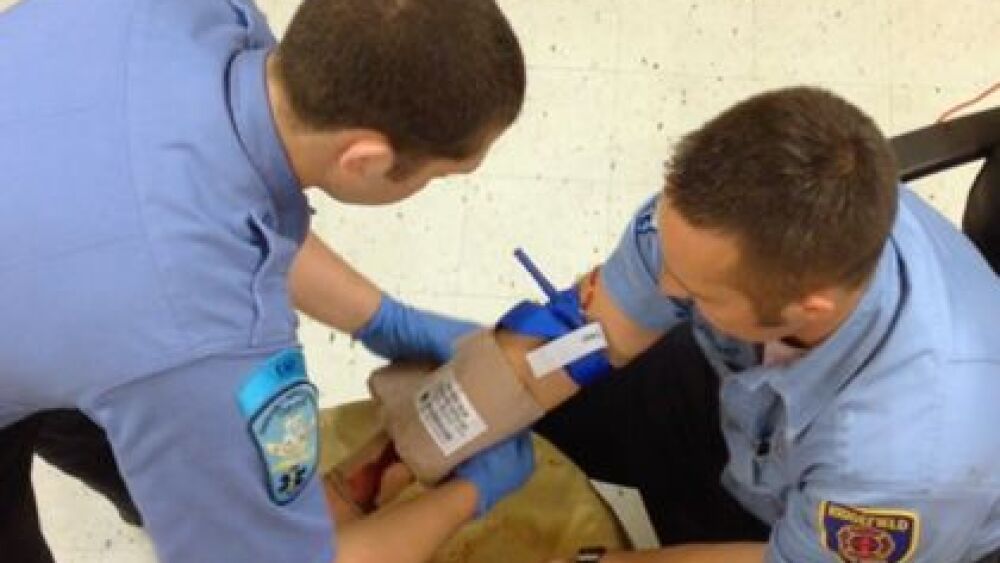By Rom Duckworth, FireRescue1 Contributor
Everybody knows the ABCs of patient care, but when it comes to trauma priorities, now there’s a better way.
Whether you are learning, teaching or practicing EMS care, the ABCs are a pretty good guide. They prioritize airway, breathing and circulation in an easy-to-remember-format applicable in most situations. But even great rules have exceptions.
Difficult trauma calls often start with more problems than we have hands to provide care with. In these cases, bleeding control is the priority, so the ABC mnemonic changes to circulation first, then airway, then breathing.
Medical patients need their ABCs? Got it! For trauma patients, call a CAB? Not so much.
That’s where MARCH comes in. Don’t think about it as a mnemonic, so much as a framework for prioritized trauma care. A prompt to address, in order, massive hemorrhage, airway control, respiratory support, circulation, hypothermia and head injury, MARCH is found in the tactical combat casualty care and advanced trauma life support courses, but is highly applicable to daily trauma care.
Here’s a breakdown of MARCH:
Massive hemorrhage
M doesn’t just remind us that bleeding control is the top priority in trauma care, it also clarifies what kind of bleeding control we are talking about. Not all bleeding control is a priority. For example, bleeding could easily refer to a spurting, lacerated artery; trickling blood from a skin tear; or a scrape that stopped losing blood before EMS even arrived.
On the other hand, massive hemorrhage gives a clear picture and means the same thing to pretty much everyone; immediate, active, life-threatening bleeding that will kill a patient if not stopped.
Massive hemorrhage can be addressed by the four Ds:
- Detect: find the source of the bleeding.
- Direct pressure: hold pressure on the source of the bleeding until the clot forms.
- Devices: if necessary, use equipment such as tourniquets, hemostatic gauze and pressure bandages to supplement direct pressure.
- Don’t dilute: use the concept of hypotensive resuscitation to avoid thinning the blood or pumping established clots.
Airway control
A reminds us that airway is still key care element for severe traumatic injuries. BLS to ALS, the patient needs a patent airway to survive.
Respiratory support
R is where breathing comes in. If a trauma patient is fighting for air, remember that not only are they not getting enough oxygen in, but they may also be using a lot of that oxygen in their failing struggle to breathe.
Assisting the patient with, or taking over respirations can move more air while simultaneously decreasing the patient’s respiratory effort using so much oxygen.
Keep in mind that over-ventilation can also do more harm than good. Ventilation provided with too much volume, speed or force can increase pressure in the chest, reducing blood return to the heart. This can have a negative effect on circulation, especially on trauma patients progressing towards shock.
Circulation
The C in MARCH refers to shock. After massive hemorrhage, airway and breathing have been addressed, we need to optimize the patient’s circulation. Standard methods for circulation improvement, such as laying the patient flat, maintaining body temperature and careful fluid resuscitation all apply.
Hypothermia
Hypothermia is a critical factor in trauma care that is not often discussed in the EMS. It is a key part of the so-called trauma triad of death, including hypothermia (low body temperature), H+ (acidosis, and which disrupts the blood’s ability to properly carry oxygen), and hypocoagulability (thinned blood or blood that has a reduced ability to clot). The trauma triad can begin with any one of these elements, and each feeds into the other.
As the patient goes into shock, his body temperature drops, reducing his blood’s ability to clot. As they bleed out more, they go further into shock, worsening their acidosis. As acidosis worsens, metabolism slows and body temperature continues to fall. And so on.
Head injury
Head injury care is virtually all about making sure that a primary injury (the initial impact) does not turn into a permanent secondary injury (injury caused or worsened by inadequate EMS care). Care for patients with severe head injuries must avoid those H bombs:
- Hypoxia: even a momentary drop in oxygen saturation can cause permanent secondary brain injury.
- Hyperventilation: as already mentioned, too much or too fast ventilation can worsen shock. In addition, hyperventilation will blow off too much CO2, causing cerebral vasoconstriction, further decreasing perfusion to the brain.
- Hypotension: as intracranial pressure increases, the blood pressure required to perfuse the brain also increases. The rule of thumb is to avoid systolic blood pressure below 90 mm/Hg.
- Hypoglycemia: while there is nothing inherent to head injury that will drop blood sugar, an injured brain deprived of needed sugar will have a worse outcome.
If ABCs are oversimplified and CAB is confusing, try MARCH as a way to learn, teach and practice prioritized trauma care to up your EMS game and improve patient outcomes.
About the author
Rom Duckworth is a dedicated emergency responder and award-winning educator with more than twenty-five years of experience working in career and volunteer fire departments, hospital health care systems, and public and private emergency services. Currently a career fire captain and paramedic EMS coordinator, Rom is an emergency services advocate, and contributor to research, magazines and textbooks on topics of leadership, emergency operations, and educational methodology. Rom is a frequent speaker at conferences and symposia around the world and can be reached via RescueDigest.com.












